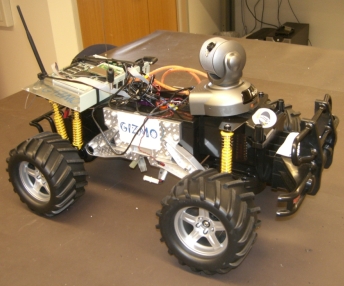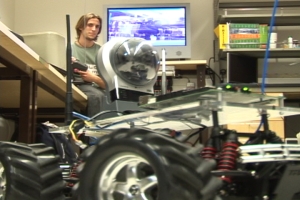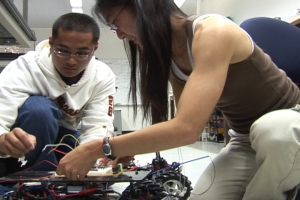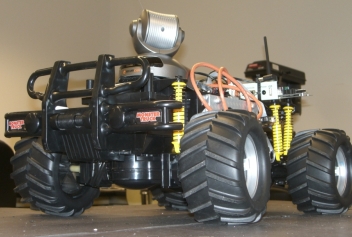Gizmo: Toy Truck Delivers
By Maureen C. Curran
|
San Diego, CA, November 22, 2006 -- Gizmo is a remote-controlled toy monster truck which has been tricked out by Calit2 UCSD researchers. At just 20"x14"x11" in size, it is tiny when compared to regular trucks, but it can deliver something that they cannot: an adaptable and reliable research platform which is reconfigurable for the task at hand.
Gizmo's "tricks" are treats for researchers. Each truck has a Calit2 CalMesh ad-hoc network board which is equipped with both wireless local area network (WLAN) and global positioning system (GPS) cards. Basic features currently include full motor capabilities (forward, reverse, braking), an override circuit for manual remote control and a web-enabled camera.
"Gizmo provides a fast way to map the WLAN spectrum and coverage outdoors, around campus for example," explains Don Kimball, a Calit2 principal development engineer. "By using a toy radio-controlled monster truck for mobility, we can use the Gizmo platform as part of our future technology road map." Kimball heads the UCSD division of Calit2's High Performance Circuits and Networking research section.
|
A single Gizmo truck can serve as an autonomous platform on wheels to deploy different technologies. The number and the type of features which can be added depends purely on the applications for which it will be used. "Gizmo can be easily modified to deploy different technologies," says Calit2 staff researcher Javier Rodriguez Molina, "it is a platform that is suited to pretty much anything." Rodriguez Molina is the lead Gizmo gadgeteer, shepherding the many staffers and students who are working on or have worked on Gizmo and its family of projects. He is also a graduate student in the Jacobs School of Engineering's Electrical and Computer Engineering (ECE) department.
The control interface is flexible; multiple types have been developed and implemented. In addition to the out-of-the box 27 Mhz radio control, Gizmo can be controlled by an 802.11 wireless interface (via webpage), Bluetooth (via webpage or cell phone) and 75 Mhz radio control.
The design and development of the necessary software and hardware to control the Gizmo truck remotely using Bluetooth technology is a very recent addition. The Gizmo remote-operated Bluetooth interface project (G.R.O.B.I.) is one of the fall quarter ECE 191 design course projects. Working with mentors Rodriguez Molina and Calit2 project scientist Paul Blair, undergraduate students Eldridge Alcantara and Kristi Tsukida have successfully developed and implemented the Bluetooth interface. Another Gizmo related ECE 191 project this quarter will enable autonomous WI-FI sniffing capabilities (mentored by Rodriguez Molina and Kimball).
|
Gizmo is an extension of the CalMesh project. CalMesh is an ad-hoc network of small, lightweight and easily reconfigurable nodes that quickly self-organize to form a reliable wireless mesh communication and data network. Both are part of Calit2's ResponSphere project.
"The Gizmo truck project is a first approach to an autonomous platform for wireless network deployment," explains Rodriguez Molina. "Using a GPS receiver and a web user interface, location coordinates can be sent to the Gizmo trucks, and they will spread out the mesh nodes in an organized and optimum way."
Gizmo is a growing family of cutting-edge research tools, with each new version better than the last. Upcoming versions will add mesh network features which will enable mobile to mobile mesh networking (vs. mobile to fixed mesh networking).
A new, larger chassis is being developed which will have significant improvements in capability, including the ability to navigate rough terrains. The number of communication channels will be expanded from three to 16 which greatly refine control of the truck and provide expanded capabilities (see accompanying video).
|
A distance/collision system has been designed and will be integrated into the system after the chassis upgrade. Improvements to the distance/collision software will expand Gizmo's ability to respond to different obstacles and environmental situations.
GPS walking directions will be added in future versions for long distance navigation. As will infrared and ultrasound obstacle avoidance, to negotiate around pedestrians. Also planned is the capability to respond to voice commands. Some Bluetooth phones have speech recognition APIs which will be used to convert speech to Gizmo commands.
The underlying motivation of the Gizmo project is to create an autonomous multi-radio platform that can be controlled by many kinds of interfaces and can be used for a wide variety of applications, such as, disaster response environments, radio frequency (RF) mapping, data gathering and educational purposes, as well as others.
Related Articles
CalMesh: Mesh Network Supports Emergency-Response Communications during Operation College Freedom
Related Projects
ResponSphere





